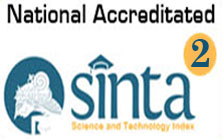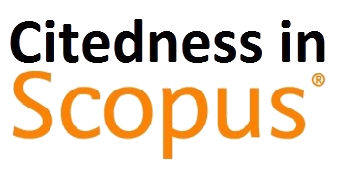Papaya Juice Treatment Increases Body Weight and Decreases Urea Levels in Lead acetate-exposed Wistar Rats
DOI:
https://doi.org/10.31965/infokes.Vol22.Iss1.1148Keywords:
Papaya Juice, Body Weight, Ureum Levels, Lead AcetateAbstract
Lead (Pb) exposure poses significant health risks due to its non-degradable nature and profound toxicity, causes oxidative stress and organ damage, particularly targeting the kidneys. Urea nitrogen levels rise as a result of decreased renal filtration rate and urea excretion. This study investigates the potential of papaya juice, rich in flavonoids, vitamins C, E, and beta-carotene, as a protective agent against Pb-induced nephrotoxicity. A Completely Randomized Design experiment was conducted, involving six treatment groups of Wistar rats. Papaya juice was administered at doses of 3.6, 7.2, and 14.4 g/200g body weight (BW) to Groups P1, P2, and P3, respectively, prior to exposure to 50 mg/kg BW of lead acetate. Group PC received vitamin E (400 IU/kg BW) and lead acetate, while Group NC was exposed to lead acetate alone. Group NT served as the control. Following a 28-day treatment period, the P3 group exhibited the most significant improvements, with a notable increase in body weight (22.50 grams) and a substantial decrease in urea nitrogen levels (18.24 mg/dl). These findings underscore the efficacy of papaya juice treatment in mitigating Pb-induced nephrotoxicity, suggesting a potential therapeutic regimen for alleviating lead toxicity in exposed populations. Eventually, the optimal dosing for papaya juice treatment, either at 14.4 g per 200 g body weight for rats or consumption of one medium-sized papaya for humans, yields compelling benefits. This regimen demonstrates significant efficacy in increasing body weight and lowering serum urea levels in rats subjected to Pb acetate exposure.
Downloads
References
Addai, Z. R., Abdullah, A., Mutalib, S. A., Musa, K. H., & Douqan, E. M. (2013). Antioxidant activity and physicochemical properties of mature papaya fruit (Carica papaya L. cv. Eksotika). Advance Journal of Food Science and Technology, 5(7), 859-865. https://doi.org/10.19026/ajfst.5.3173
Collin, M. S., Venkatraman, S. K., Vijayakumar, N., Kanimozhi, V., Arbaaz, S. M., Stacey, R. S., ... & Swamiappan, S. (2022). Bioaccumulation of lead (Pb) and its effects on human: A review. Journal of Hazardous Materials Advances, 7, 100094. https://doi.org/10.1016/j.hazadv.2022.100094
El-Neweshy, M. S., & El-Sayed, Y. S. (2011). Influence of vitamin C supplementation on lead-induced histopathological alterations in male rats. Experimental and Toxicologic Pathology, 63(3), 221-227. https://doi.org/10.1016/j.etp.2009.12.003
Eshginia, S., & Marjani, A. (2013). The effect of vitamin C on the erythrocyte antioxidant enzymes in intoxicated-lead rat offsprings. Journal of clinical and diagnostic research: JCDR, 7(6), 1078–1081. https://doi.org/10.7860/jcdr/2013/5310.3059
Flora, S. J., & Pachauri, V. (2010). Chelation in metal intoxication. International journal of environmental research and public health, 7(7), 2745-2788. https://doi.org/10.3390/ijerph7072745
Fukai, T., & Ushio-Fukai, M. (2011). Superoxide dismutases: role in redox signaling, vascular function, and diseases. Antioxidants & redox signaling, 15(6), 1583-1606. https://doi.org/10.1089/ars.2011.3999
Gusnita, D. (2012). Pencemaran logam berat timbal (Pb) di udara dan upaya penghapusan bensin bertimbal. Berita Dirgantara, 13(3), 95–101.
Ghanwat, G., Patil, A. J., Patil, J., Kshirsagar, M., Sontakke, A., & Ayachit, R. K. (2016). Effect of vitamin C supplementation on blood Lead level, oxidative stress and antioxidant status of battery manufacturing Workers of Western Maharashtra, India. Journal of clinical and diagnostic research: JCDR, 10(4), 8–11. https://doi.org/10.7860/jcdr/2016/15968.7528
Iamjud, K., Srimat, S., Sangwanangkul, P., Wasee, S., & Thaipong, K. (2016). Antioxidant properties and fruit quality of selected papaya breeding lines. ScienceAsia, 42(5), 332-339.
Jang, M. H., Piao, X. L., Kim, J. M., Kwon, S. W., & Park, J. H. (2008). Inhibition of cholinesterase and amyloid‐β aggregation by resveratrol oligomers from Vitis amurensis. Phytotherapy Research: An International Journal Devoted to Pharmacological and Toxicological Evaluation of Natural Product Derivatives, 22(4), 544-549.
Kamilatussaniah, K., Yuniastuti, A., & Iswari, R. S. (2015). Pengaruh suplementasi madu kelengkeng terhadap kadar TSA dan MDA tikus putih yang diinduksi timbal (Pb). Indonesian Journal of Mathematics and Natural Sciences, 38(2), 108-114.
Kordas, K. (2017). The “lead diet”: can dietary approaches prevent or treat lead exposure?. The Journal of pediatrics, 185, 224-231. https://doi.org/10.1016/j.jpeds.2017.01.069
Kumar, A., Kumar, A., MMS, C. P., Chaturvedi, A. K., Shabnam, A. A., Subrahmanyam, G., ... & Yadav, K. K. (2020). Lead toxicity: health hazards, influence on food chain, and sustainable remediation approaches. International journal of environmental research and public health, 17(7), 2179. https://doi.org/10.3390/ijerph17072179
Michalak, A. (2006). Phenolic compounds and their antioxidant activity in plants growing under heavy metal stress. Polish journal of environmental studies, 15(4), 523–530. https://doi.org/10.1016/j.fitote.2011.01.018
Muliyadi, M. (2015). Paparan timbal udara terhadap timbal darah, hemoglobin, cystatin C serum pekerja pengecatan mobil. Jurnal Kesehatan Masyarakat, 11(1), 87-95. https://doi.org/10.15294/kemas.v11i1.3519
Purlinda, D. E., Simanjuntak, S. B. I., & Saryono, S. (2020). Potensi Jus Buah Pepaya (Carica Papaya L.) Mencegah Nefrotoksisitas pada Tikus Wistar yang Terpapar Pb Asetat. Majalah Ilmiah Biologi Biosfera: A Scientific Journal, 37(2), 97-105. https://doi.org/10.20884/1.mib.2020.37.2.860
Ramah, A., EL-shwarby, R., MA, N., & El-shewey, E. A. (2015). The effect of lead toxicity on male albino rats reproduction with ameliorate by vitamin E and pumpkin seeds oil. Benha Veterinary Medical Journal, 28(1), 43-52.
Rizal, F. (2022). Review: Analysis of lead level in the blood of several professions in Indonesia. Asian Journal of Health and Applied Sciences, 1(1), 15–22. https://doi.org/10.53402/ajhas.v1i1.3
Rosyidah, H., & Djannah, S. N. (2010). Hubungan antara kadar pb dalam darah dengan kejadian hipertensi pada operator SPBU di kota Yogyakarta. Kes Mas: Jurnal Fakultas Kesehatan Masyarakat Universitas Ahmad Daulan, 4(2), 104-111.
Sadeque, M. Z., Begum, Z. A., Umar, B. U., Ferdous, A. H., Sultana, S., & Uddin, M. K. (2012). Comparative efficacy of dried fruits of Carica papaya Linn. and Vitamin-E on preventing hepatotoxicity in rats. Faridpur Med College J, 7, 29-32.
Sancho, L. E. G. G., Yahia, E. M., & González-Aguilar, G. A. (2011). Identification and quantification of phenols, carotenoids, and vitamin C from papaya (Carica papaya L., cv. Maradol) fruit determined by HPLC-DAD-MS/MS-ESI. Food Research International, 44(5), 1284-1291. https://doi.org/10.1016/j.foodres.2010.12.001
Sasmita, F. W., Susetyarini, E., Husamah, H., & Pantiwati, Y. (2017). Efek ekstrak daun kembang bulan (Tithonia diversifolia) terhadap kadar glukosa darah tikus wistar (Rattus norvegicus) yang diinduksi alloxan. Majalah Ilmiah Biologi BIOSFERA: A Scientific Journal, 34(1), 22-31. https://doi.org/10.20884/1.mib.2017.34.1.412
Sari, W. D., & Santika, I. W. M. (2023, November). Potensi Tanaman Pepaya (Carica papaya L.) sebagai Nefroprotektor. Prosiding Workshop dan Seminar Nasional Farmasi, 2,700-715. https://doi.org/10.24843/wsnf.2022.v02.p56
Sudjarwo, S. A., Eraiko, K., & Sudjarwo, G. W. (2019). The potency of chitosan-Pinus merkusii extract nanoparticle as the antioxidant and anti-caspase 3 on lead acetate-induced nephrotoxicity in rat. Journal of advanced pharmaceutical technology & research, 10(1), 27-32. https://doi.org/10.4103/japtr.japtr-306-18
Suhartono, E., Nijka, J. A., Anhar, V. Y., Sari, R. A., Edyson, E., & Marisa, D. (2015). Anti-lipid peroxidation activities of three selected fruits juices against cadmium induced liver damage in vitro. Journal of Tropical Life Science, 5(2), 75-79.
Usmayani, S. N., Basuki, E., & Yasa, I. W. S. (2015). Penggunaan Kalium Permanganat (KMnO4) pada Penyimpanan Buah Pepaya California (Carica papaya L.). Pro Food, 1(2), 48-55.
Wall, M. M. (2006). Ascorbic acid, vitamin A, and mineral composition of banana (Musa sp.) and papaya (Carica papaya) cultivars grown in Hawaii. Journal of Food Composition and analysis, 19(5), 434-445. https://doi.org/10.1016/j.jfca.2006.01.002
Wani, A. L., Ara, A., & Usmani, J. A. (2015). Lead Toxicity: A Review. Interdisciplinary Toxicology, 8(2), 55–64. https://doi.org/10.1515/intox-2015-0009
Wulandari, E. T., Wulandari, D. D., Qodriyah, N. L., & Rohmah, W. (2020, December). Faktor-Faktor Yang Mempengaruhi Kadar Timbal (Pb) Dalam Darah Secara Fisiologis. Prosiding National Conference for Ummah, 1(1).
Yuniarti, W. M., Krismaharani, N., Ciptaningsih, P., Celia, K., Veteriananta, K. D., Ma’ruf, A., & Lukiswanto, B. S. (2021). The protective effect of Ocimum sanctum leaf extract against lead acetate-induced nephrotoxicity and hepatotoxicity in mice (Mus musculus). Veterinary World, 14(1), 250–258. https://doi.org/10.14202/vetworld.2021.250-258
Zhai, Q., Narbad, A., & Chen, W. (2014). Dietary strategies for the treatment of cadmium and lead toxicity. Nutrients, 7(1), 552-571. https://doi.org/10.3390/nu7010552
Downloads
Published
How to Cite
Issue
Section
License
Copyright (c) 2024 JURNAL INFO KESEHATAN

This work is licensed under a Creative Commons Attribution-NonCommercial-ShareAlike 4.0 International License.
Copyright notice
Ownership of copyright
The copyright in this website and the material on this website (including without limitation the text, computer code, artwork, photographs, images, music, audio material, video material and audio-visual material on this website) is owned by JURNAL INFO KESEHATAN and its licensors.
Copyright license
JURNAL INFO KESEHATAN grants to you a worldwide non-exclusive royalty-free revocable license to:
- view this website and the material on this website on a computer or mobile device via a web browser;
- copy and store this website and the material on this website in your web browser cache memory; and
- print pages from this website for your use.
- All articles published by JURNAL INFO KESEHATAN are licensed under the Creative Commons Attribution 4.0 International License. This permits anyone to copy, redistribute, remix, transmit and adapt the work provided the original work and source is appropriately cited.
JURNAL INFO KESEHATAN does not grant you any other rights in relation to this website or the material on this website. In other words, all other rights are reserved.
For the avoidance of doubt, you must not adapt, edit, change, transform, publish, republish, distribute, redistribute, broadcast, rebroadcast or show or play in public this website or the material on this website (in any form or media) without appropriately and conspicuously citing the original work and source or JURNAL INFO KESEHATAN prior written permission.
Permissions
You may request permission to use the copyright materials on this website by writing to jurnalinfokesehatan@gmail.com.
Enforcement of copyright
JURNAL INFO KESEHATAN takes the protection of its copyright very seriously.
If JURNAL INFO KESEHATAN discovers that you have used its copyright materials in contravention of the license above, JURNAL INFO KESEHATAN may bring legal proceedings against you seeking monetary damages and an injunction to stop you using those materials. You could also be ordered to pay legal costs.
If you become aware of any use of JURNAL INFO KESEHATAN copyright materials that contravenes or may contravene the license above, please report this by email to jurnalinfokesehatan@gmail.com
Infringing material
If you become aware of any material on the website that you believe infringes your or any other person's copyright, please report this by email to jurnalinfokesehatan@gmail.com.


















